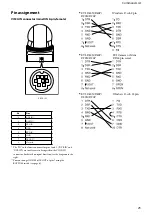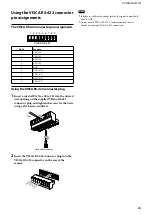
11
Basic Functions
Exposure Compensation
Exposure compensation is a function which offsets the
internal reference brightness level used in the AE mode
by steps of 1.5 dB.
Data
Step
Setting value
0E
+
+10.5 dB
0D
+6
+9 dB
0C
+5
+.5 dB
0B
+4
+6 dB
0A
+3
+4.5 dB
09
+2
+3 dB
08
+1
+1.5 dB
0
0
0 dB
06
–1
–1.5 dB
05
–2
–3 dB
04
–3
–4.5 dB
03
–4
–6 dB
02
–5
–.5 dB
01
-6
-9 dB
00
-
-10.5 dB
High Resolution Mode
A newly developed ISP function enables the filtering
of signals. This allows the camera to provide images
with a high resolution.
Aperture Control
Aperture control is a function which adjusts the
enhancement of the edges of objects in the picture.
There are 16 levels of adjustment, starting from “no
enhancement.” When shooting text, this control may
help by making the text sharper.
Back Light Compensation
When the background of the subject is too bright, or
when the subject is too dark due to shooting in the AE
mode, back light compensation will make the subject
appear clearer.
Wide Dynamic Range Mode (WD) (EVI-D90N/P
only)
The Wide Dynamic Range mode is a function for
dividing an image into several blocks and correcting
blocked-up shadows and blown-out highlights in
accordance with the intensity difference. It enables you
to obtain images in which portions ranging from dark
to light can be recognized, even when capturing a
subject with a large intensity difference that is backlit
or includes extremely light portions.
A CCD for shooting a wide dynamic range is
employed, and a newly developed image signal
processor combines a long exposure signal (normal
shutter) and a signal of the high intensity portions
obtained by a short exposure (high-speed shutter) to
achieve images with a wide dynamic range.
Wide Dynamic Range Auto On/Off Mode
The wide dynamic range can be set to be automatically
switched ON/OFF in accordance with the intensity
difference obtained by dividing an image into several
blocks and then averaging the intensity of each block.
Wide Dynamic Range Auto On/Off Mode
Auto On/Off
When the intensity
difference between the
dark portions and light
portions of a subject
becomes large because
of back lighting or the
like, the wide dynamic
range mode is switched
ON.
When the subject
changes and the
intensity difference
between the dark
portions and light
portions becomes
small, the wide dynamic
range mode is switched
OFF.












































